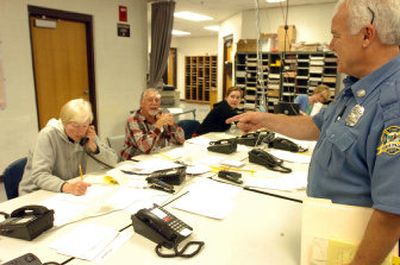Best prepared to handle worst

In case of emergency, head to Idaho. According to the National Association of County and City Health Officials, Idaho is the only state in the nation prepared from border to border to respond to natural or planned disasters.
NACCHO honored 15 public health agencies across the nation Wednesday, declaring them Public Health Ready. Eight agencies serve portions of eight different states, but seven are Idaho’s public health districts, which serve the entire state. Among those seven Idaho agencies is North Idaho’s Panhandle Health District.
“NACCHO commends Panhandle Health District for being a model of public health emergency preparedness,” said Patrick Libbey, NACCHO executive director. “The public health system still has work to do when it comes to preparedness, but we are making some great strides thanks to the good work of Panhandle Health District.”
Public Health Ready means Idaho has a detailed plan ready to go into action moments after any type of disaster. Every region in the state has databases that include the names of hundreds of volunteers and their expertise. Hospitals, school districts, law enforcement and other agencies have accepted jobs to perform in emergencies, even procuring precious medical supplies from a national stockpile. Health districts led the charge.
“This has been a concerted effort across a large geographic area that has paid off handsomely,” Mike Journee, press secretary for Gov. Dirk Kempthorne, said Wednesday. “It’s a great recognition and testament to the coordination and efforts of all the (health) districts.”
Idaho’s recognition came after three years of planning and practicing, said Paul Ziaya, public health preparedness planner for Panhandle Health District.
“We didn’t design the plan with this (recognition) in mind,” Ziaya said. “We designed it to create capabilities for the community.”
In North Idaho, the plan means communities are full of people who know what to do in the event of major flooding, a terrorist attack or even an outbreak of Asian flu. Ziaya said the Panhandle has 1,200 volunteers ready to serve on a medical reserve team. Many of those people have medical training but many offer non-medical support services, such as truck driving or heavy machinery operation.
“It’s fairly astounding, just the sheer number of people willing to step forward,” Ziaya said. “Some communities struggle to get 70 volunteers and we have 1,200.”
All those people have trained, he said. The plan involves regular drills so volunteers keep their skills updated. Last month, the preparedness group simulated a smallpox outbreak in Sandpoint. Law enforcement, volunteers and health workers convened at Sandpoint High.
“We went through the whole process from start to finish of moving people through and teaching them,” Ziaya said. “We did mock shots, paper processing, counseling with doctors. We did everything as if it were real.”
If Asian flu breaks out in Kootenai County, Kootenai Medical Center and school districts will serve as clinics where people would receive medication, Ziaya said. Police and sheriff’s deputies would provide security and manage traffic. Emergency operations in the county would serve as the command center, he said.
“The reality is the work is far from done,” Ziaya said. “One of the things we know is that readiness is a perishable commodity. We have a sound foundation in exercise and agreements, but we have to continue to work on it.”
The national recognition for emergency preparedness doesn’t surprise Kootenai County Commissioner Katie Brodie.
“I felt safe watching our Emergency Operations Center during the horrible mess in the last six weeks,” she said, referring to the Groene family tragedy at Wolf Lodge. “Had it not been for the emergency planning and staff readiness, we wouldn’t have gotten the support we did from all the other agencies. In every field and endeavor, we’re emergency prepared.”